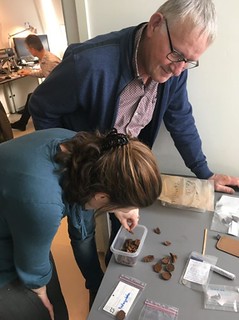
The University of Leiden published an article about an interesting find of Roman coins believed to be offerings for the safe crossing of a river.
-Editor

Several years ago, two amateur archaeologists from Brabant discovered over a hundred Roman coins near to Berlicum in the north of the province. After years of research, it now appears that the location, close to a ford in the river, was a site for offerings. Another interesting fact is that the coins offered were chosen very precisely. ‘This was an important eureka moment in my academic career.'
What made you conclude that this must have been a site for offerings?
Claes: ‘You can determine from different characteristics that this was not a hoard of valuable treasure that people deliberately buried for later. With finds like that, the coins would be in a chest or amphora, but that wasn't the case here. These coins were lying spread over a large area and were just loose in the earth. Also, they turned out not to be particularly valuable coins. What we found were mainly bronze coins; there were no gold ones, for example. That's not what you'd expect if the find were a treasure trove. Finally, the coins were from a very broad time period: the oldest coins date from the Republic [up to 27 BC, Ed.] and the most recent from the time of Emperor Marcus Aurelius [up to 180 AD]. This indicates that the coins must have been deposited by different people over a long period.'’
 What was the deciding factor?
What was the deciding factor?
‘In the 1832 entry in the land registry - one of the Netherlands' oldest detailed maps - my colleagues noticed that at that time there was a path cutting across the river. Apparently there was a ford on this spot, where people could wade through the river. Later, the ford fell into disuse. This information, together with the find of the coins, convinced us that travellers in Roman times brought offerings here for a safe crossing. It may not have been a particularly rapidly flowing river, but for traders in particular it was important to be able to transport their goods safely to the other side. And there's also the fact that in ancient times rivers always had some sacred connections.
What surprised you most about this site?
‘I was mainly involved in studying the coins themselves. I looked at whether the travellers selected particular coins for their offerings. It seems that they did: coins with military imagery seemed to be popular offerings. Initially, I thought that was odd, because what does a military image have to do with a safe crossing? But then I realised that this was also quite common before Roman times: we regularly find offerings of axes, swords and helmets in other rivers and stretches of water. This could be a pre-Roman custom that continued in the Roman period but in a different way. That was an important eureka moment in my academic career.'
To read the complete article, see:
Hoard of Roman coins turns out to be offering for safe crossing
(https://www.universiteitleiden.nl/en/news/2021/06/roman-coins-as-offering-for-safe-crossing)
THE BOOK BAZARRE
1946–2021: CELEBRATING 75 YEARS of the RED BOOK.
The 75th edition of the Guide Book of United States Coins will release next week, April 7, 2021. Preorder now to reserve your copy—online
at
Whitman.com
, or call 1-800-546-2995.
Wayne Homren, Editor
The Numismatic Bibliomania Society is a non-profit organization
promoting numismatic literature. See our web site at coinbooks.org.
To submit items for publication in The E-Sylum, write to the Editor
at this address: whomren@gmail.com
To subscribe go to: https://my.binhost.com/lists/listinfo/esylum
Copyright © 1998 - 2024 The Numismatic Bibliomania Society (NBS)
All Rights Reserved.
NBS Home Page
Contact the NBS webmaster
| 


